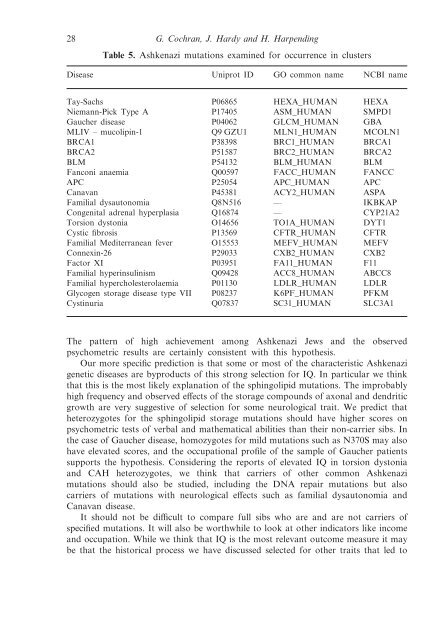natural history of ashkenazi intelligence - Henry C Harpending ...
natural history of ashkenazi intelligence - Henry C Harpending ...
natural history of ashkenazi intelligence - Henry C Harpending ...
Create successful ePaper yourself
Turn your PDF publications into a flip-book with our unique Google optimized e-Paper software.
28 G. Cochran, J. Hardy and H. <strong>Harpending</strong><br />
Table 5. Ashkenazi mutations examined for occurrence in clusters<br />
Disease Uniprot ID GO common name NCBI name<br />
Tay-Sachs P06865 HEXA_HUMAN HEXA<br />
Niemann-Pick Type A P17405 ASM_HUMAN SMPD1<br />
Gaucher disease P04062 GLCM_HUMAN GBA<br />
MLIV – mucolipin-1 Q9 GZU1 MLN1_HUMAN MCOLN1<br />
BRCA1 P38398 BRC1_HUMAN BRCA1<br />
BRCA2 P51587 BRC2_HUMAN BRCA2<br />
BLM P54132 BLM_HUMAN BLM<br />
Fanconi anaemia Q00597 FACC_HUMAN FANCC<br />
APC P25054 APC_HUMAN APC<br />
Canavan P45381 ACY2_HUMAN ASPA<br />
Familial dysautonomia Q8N516 — IKBKAP<br />
Congenital adrenal hyperplasia Q16874 — CYP21A2<br />
Torsion dystonia O14656 TO1A_HUMAN DYT1<br />
Cystic fibrosis P13569 CFTR_HUMAN CFTR<br />
Familial Mediterranean fever O15553 MEFV_HUMAN MEFV<br />
Connexin-26 P29033 CXB2_HUMAN CXB2<br />
Factor XI P03951 FA11_HUMAN F11<br />
Familial hyperinsulinism Q09428 ACC8_HUMAN ABCC8<br />
Familial hypercholesterolaemia P01130 LDLR_HUMAN LDLR<br />
Glycogen storage disease type VII P08237 K6PF_HUMAN PFKM<br />
Cystinuria Q07837 SC31_HUMAN SLC3A1<br />
The pattern <strong>of</strong> high achievement among Ashkenazi Jews and the observed<br />
psychometric results are certainly consistent with this hypothesis.<br />
Our more specific prediction is that some or most <strong>of</strong> the characteristic Ashkenazi<br />
genetic diseases are byproducts <strong>of</strong> this strong selection for IQ. In particular we think<br />
that this is the most likely explanation <strong>of</strong> the sphingolipid mutations. The improbably<br />
high frequency and observed effects <strong>of</strong> the storage compounds <strong>of</strong> axonal and dendritic<br />
growth are very suggestive <strong>of</strong> selection for some neurological trait. We predict that<br />
heterozygotes for the sphingolipid storage mutations should have higher scores on<br />
psychometric tests <strong>of</strong> verbal and mathematical abilities than their non-carrier sibs. In<br />
the case <strong>of</strong> Gaucher disease, homozygotes for mild mutations such as N370S may also<br />
have elevated scores, and the occupational pr<strong>of</strong>ile <strong>of</strong> the sample <strong>of</strong> Gaucher patients<br />
supports the hypothesis. Considering the reports <strong>of</strong> elevated IQ in torsion dystonia<br />
and CAH heterozygotes, we think that carriers <strong>of</strong> other common Ashkenazi<br />
mutations should also be studied, including the DNA repair mutations but also<br />
carriers <strong>of</strong> mutations with neurological effects such as familial dysautonomia and<br />
Canavan disease.<br />
It should not be difficult to compare full sibs who are and are not carriers <strong>of</strong><br />
specified mutations. It will also be worthwhile to look at other indicators like income<br />
and occupation. While we think that IQ is the most relevant outcome measure it may<br />
be that the historical process we have discussed selected for other traits that led to


